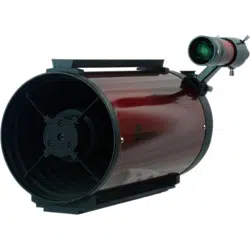Loading ...
Loading ...
Loading ...

8
The small black screws are merely locking screws,
which should be loosened before adjusting the
mirror’s tilt. The larger chrome screws are
spring-loaded collimation screws that actually adjust
the tilt of the primary mirror. Turn these collimation
screws only a fraction of a turn at a time, for example,
1/8 turn. Turn one and check the view through the
Cheshire to see if it improved the white optical axis
ring. Keep tweaking the collimation screws, each time
checking the optical axis ring, until it is concentric and
uniform in width. Then tighten the three lock
setscrews to fix the mirror in that position.
After adjusting the optical axis, re-check the
collimation of the secondary mirror and make any
necessary adjustments, then recheck the optical axis
collimation. Generally, optical axis collimation will not
need to be performed very often.
Star Testing
A star test can be used to further improve and confirm
the collimation accuracy of the telescope. It needs to
be performed in the night sky using a real star. Get
the telescope ready for the star test.
Remove the Cheshire eyepiece.
Install all extension rings between the telescope’s
rear cell and the focuser.
Insert an eyepiece directly into the focuser
drawtube by using the 1.25” ring adapter. The
eyepiece should provide moderate to high
magnification.
DO NOT use a star diagonal.
An ideal target is a star close to the zenith (straight
overhead) rather than at the horizon to minimize
atmospheric distortions. Using Polaris as your target
star can be helpful as minimal drift adjustments will
be required. Center the star in the field of view.
Slowly de-focus the image with the focusing knob
until you can see a series of concentric diffraction
rings form around the dark disk in the center. That
dark disk is the shadow of the secondary mirror.
In a well collimated telescope, the diffraction rings
should appear round and concentric, with the dark
disk exactly in the center. If the dark central disk is off
center, the scope is out of collimation. Adjust the
collimation of the secondary mirror and, only if
necessary, the primary mirror while monitoring the
defocused star until the dark central disk is exactly
centered in the diffraction rings. The adjustment
procedure on the telescope mirrors is the same as
described in Part ‘Secondary Mirror Adjustment’ and
‘Optical Axis (Primary Mirror) Adjustment’.
NOTE: It is important when checking or adjusting
the collimation using a star, that the star be
positioned in the center of the eyepiece’s field of
view. If it isn’t, the optics will always appear out
of collimation, even though they may be perfectly
aligned! It is critical to keep the star centered, so
over time you may need to make slight
corrections to the telescope’s position.
Loading ...
